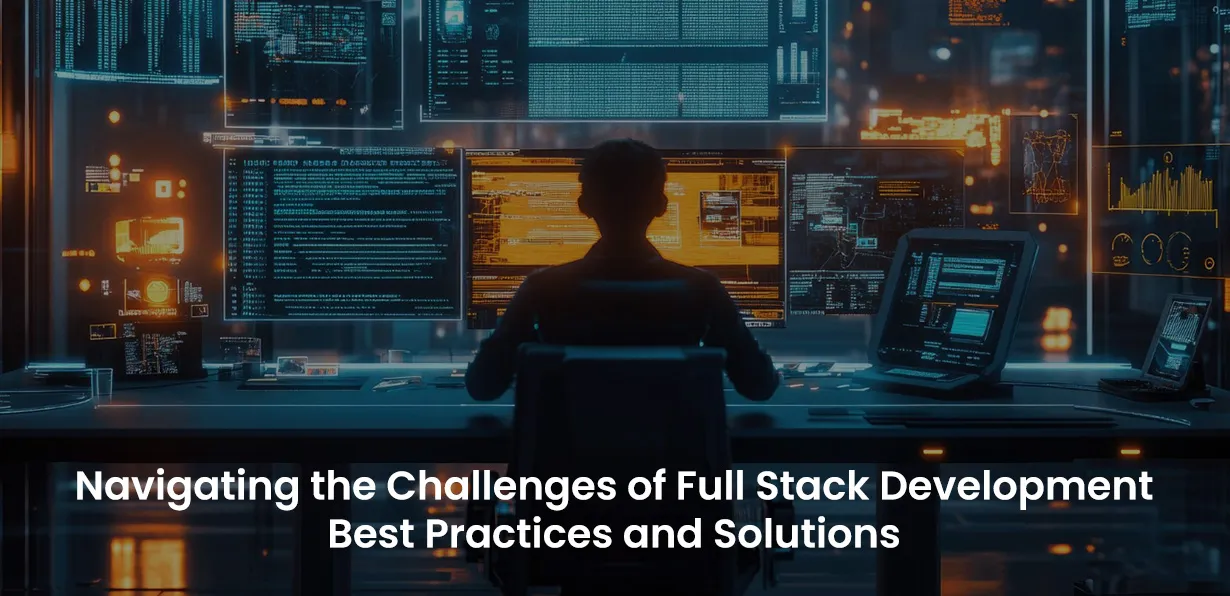Navigating the Challenges of Full Stack Development – Best Practices and Solutions
Full-stack development brings many challenges and opportunities to developers, as it involves building, designing, and testing a web application from scratch. In simple words, “full stack” means an entire procedure for software development. It includes both front-end and back-end technologies. Developers must be proficient in many programming languages, databases, frameworks, and server management.
What is Full-stack development?
Full-stack development can be defined as working through the technology stack, from the front end to the rear end. It also has many advantages: a competent set of skills and the opportunity to develop consistent applications; at the same time, it has its own problems. In this blog, I will focus on these challenges while giving you the right recommendations on how to tackle them. However, it is necessary to note that full-stack development is a rather diverse and promising sphere today that opens up myriad opportunities for continuous development and experimentation.
What are the challenges of full-stack development?
Full-stack development involves different technologies, such as front-end and back-end programming languages, databases, frameworks, etc. This large spectrum of experience may be considered a major issue as each technology possesses its own characteristics, which means that to work with a specific technology, one has to study it and constantly improve one’s knowledge. The existence of so many tools and the characteristics of each of them, as well as the proper ways of interrelating them within a project, are of great importance at the same time.
The process of integrating front-end and back-end development.
The primary concern in full-stack development is effectively integrating the front and back ends. This integration entails UI/UX compatibility that connects both application sides. Data has to be transferred without any issues between front-end and back-end components, so developers need to have a good understanding of how these components are integrated. This can only be done by carefully planning how the website would look and function while having a good understanding of basic web development languages such as HTML, CSS, and JavaScript, among others, server-side languages, and databases.
Handling Project Scope
Full-stack development is carried out on large projects that are made up of many sub-projects, and these need to be well coordinated. This may complicate matters concerning the management of project scope with regard to the time required and the level of quality delivered for each task. These are some of the issues that developers must understand in order to manage the goals of projects, time, and change.
Debugging and issue resolution
Testing and problem-solving are highly relevant in the field of full-stack development. The problem is that full-stack projects can become intricate, so tasks like quickly detecting and solving problems will be even more challenging. An additional necessary skill for developers can be defined as the skill of concentrated and deep troubleshooting to provide the best performance of the whole system. It involves not only the search for defects and their correction but also the consideration of ways in which modifications in one area of the stack can impact the rest of it.
Keeping Up to Date with the Latest Technologies
Full-stack development is frequently innovated, and new technologies and frameworks are constantly being developed. Keeping up with these changes is a big problem for developers, as it involves spending time and learning new tools and approaches. It takes sustained efforts to maintain such positioning and provide innovative and effective solutions.
Best Practices
To navigate these challenges, several best practices can be employed:
1. Version control is crucial.
Source control software such asGIT is vital when it comes to managing changes to code or working in a team. It facilitates the recording of modifications, the return to prior states if required, and the organisation of the development process when multiple individuals are involved. Integrating version control into the development life cycle affords the actual complexities of full-stack projects and makes the workflow more effective.
2. Clear Coding
As part of their development workflow, full-stack developers focus on the code’s readability and sustainability. This practice entails using meaningful names for variables, documenting one’s code properly, and not complicating things. Clean code improves the legibility of code, reducing the time necessary to make changes and making it possible for the code base to stay manageable throughout development.
3. System and Code Testing and Debugging Tools
Automation testing and debugging tools are very helpful in coming across hassles and solving them conveniently. To execute test cases and debug, there are tools likeSelenium, which can automatically do testing, andChrome Dev toolsthat help improve the code’s quality and come in handy to save the projects’ time. One is that through automated testing, new changes do not bring in bugs; second, through debugging tools, one can identify and locate bugs easily.
4. Continuous learning is the key to success.
Due to the dynamic nature of the technologies involved in full-stack development, learning is mandatory in this field. Developers should take on the responsibility of sourcing new information through conferences, workshops, online forums, media, and articles. The finding that embracing the culture of continuing professional development assists developers in staying abreast of new trends and developments to enable them to address new challenges that arise in their field of practice corroborates this assertion.
Conclusion:
Full-stack development is proving to be an extremely intense but fruitful area of knowledge and operation. This can be smoothed through mastering many technologies, blending front-end and back-end, proper project scope management, efficient debugging, and always being updated with new technologies. Other principles like version control, code clarity, testing automation, and consistent learning make it easy to deliver quality, sustainable, and expandable applications.
Not only does this empower your team in evolving areas like full-stack development, where the landscape is still shifting, but there is also always a need for additional experience when dealing with particularly massive projects. Thus, working with qualified full-stack developers and applying such a service as Nettyfy can improve the results of projects and achieve success in such a competitive sphere.


